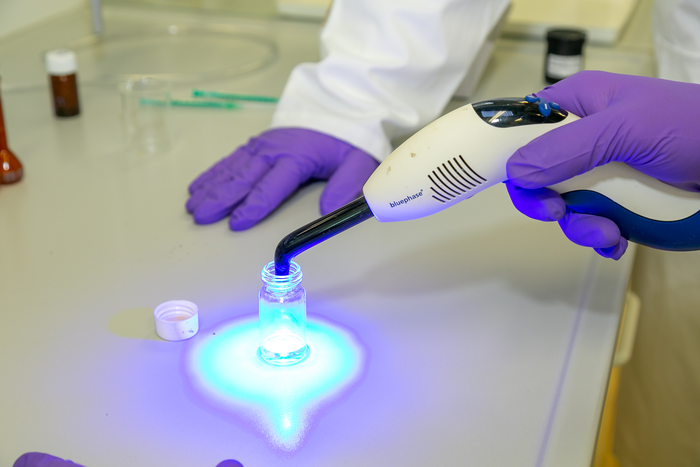Anyone who has ever been in the dentist's chair with a hole in their tooth is probably familiar with the procedure. After the hole in the tooth is drilled, a filling made of liquid plastic is inserted. This is then modelled in the mouth and hardened (cured) by UV light. This is made possible by so-called photoinitiators. These are chemical compounds that are added to the filling paste. They decompose when exposed to light and form radicals that cause this paste to harden.
For some years now, germanium-based photoinitiators have been used for this purpose. The advantage of these is that they absorb light with longer wavelength and therefore do not require UV light, which is hazardous to health, for curing. This non-toxic photoinitiator has already established itself in the dental field, although it is expensive to produce. The production costs of one kilogram of this initiator are currently in the order of magnitude of a new small car. "Given the small quantities needed for dental fillings, the price of the photoinitiator is hardly a factor in the dental industry. For other applications, however, the expensive production was a stumbling block – until now," explains chemist Michael Haas from Graz University of Technology (TU Graz) in Austria.

Together with his team at the Institute of Inorganic Chemistry, Haas has developed a completely new method of synthesis for germanium-based photoinitiators. In contrast to conventional synthesis, this production method not only does not require sulphur ("a smell you don't necessarily want in your mouth"), but is also significantly simpler, more efficient and cheaper. We have succeeded in establishing an alternative approach to this class of compounds that is single-step and makes isolating the product absolutely simple." In the process, several silicon-based protective groups are cleaved off simultaneously. The desired compound is then isolated by simple crystallization. This opens up further biomedical applications for this class of photoinitiators, for example in the production of contact lenses, prostheses, novel implants and artificial human tissue.
The researchers have now translated this alternative approach into application with the project partner Ivoclar Vivadent AG. The dental company already had a toxicologically safe germanium-based photoinitiator (Ivocerin®) in its product portfolio. However, this also has serious disadvantages in production, as Haas explains: "In the case of Ivocerin®, the synthesis is complex and multi-step process, and the removal of the reaction partners is also expensive and leads to enormous yield losses." The foreseeable market launch of the new initiator will make dental fillings significantly cheaper in the future.
Reg Office: Room 435, Building 9, No.2568 Gudai Road, Minhang District, Shanghai, China.
Pilot Lab: Building 1, No. 589 Qinling Street, Shijiazhuang High-tech Zone,Hebei, China.
Plant Unit 1: Xincheng town clean chemical park, Xinji, Hebei, China.
Plant Unit 2: Dongming County South Chemical Park, Heze City, China.
Tel: +86-21-34943721
Email:Massive@massivechem.com
Info@massivechem.com
Shanghai Massive Chemical Technology Co., Ltd. All Rights Reserved(C)2023 Supported by Record number:沪ICP备18008139号